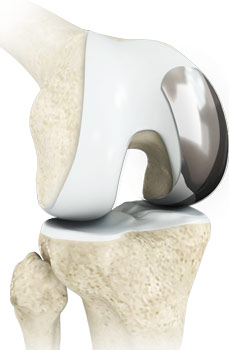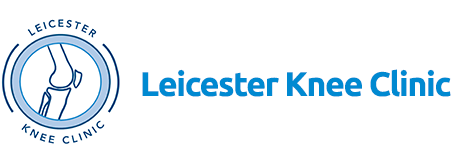Unicompartmental/Partial Knee Replacement Surgeon in Leicester

Mr Ghosh is a specialist in performing unicompartmental (partial) knee replacements. Patients with osteoarthritis that is confined to a single compartment of the knee may be candidates for a unicompartmental knee replacement, in which only the damaged compartment of the knee is replaced with an implant rather than the whole knee. This means faster recovery, a better feeling knee and less risk in surgery compared to a total knee replacement. Please see below for further information. Mr. Ghosh provides diagnosis and minimally invasive unicompartmental knee replacement surgery in Leicester. Contact Mr. Ghosh's office for an appointment.

What is a Unicompartmental (partial) Knee Replacement?
Unicompartmental knee replacement is a minimally invasive surgery in which only the damaged compartment of the knee is replaced with an implant. It is also called a partial knee replacement. In this procedure only the damaged parts of the knee are replaced while the undamaged part is left alone. This is different from a Total Knee Replacement where the majority of the joint is replaced regardless of whether there is damage.
The knee can be divided into three compartments: patellofemoral (the compartment in front of the knee between the kneecap and thighbone), the medial compartment (on the inside portion of the knee) and the lateral compartment (area on the outside portion of the knee joint). Each part can be replaced according to where the damage is.
Disease Overview of Arthritis
Arthritis is the wearing away and inflammation of a joint that causes pain, swelling (inflammation) and stiffness.
Osteoarthritis is the most common form of knee arthritis, in which the joint cartilage gradually wears away. It most often affects older people but can also affect younger patients. In a normal joint, articular cartilage allows for smooth movement within the joint, whereas in an arthritic knee the cartilage itself becomes thinner or completely absent. In addition, the bones become thicker around the edges of the joint and may form bony spurs. These factors can cause pain as rather than cartilage rubbing on cartilage you may have bone rubbing against bone. It can also cause a restricted range of motion in the joint.
Diagnosis of Arthritis
Mr Ghosh will diagnose osteoarthritis based on your medical history, physical examination, and X-rays. X-rays typically show a narrowing of joint space in the arthritic knee.
Treatment for Arthritis
There are many treatments indicated for arthritis – both conservative and surgical. Mr Ghosh will discuss the best option depending on your individual condition.
Indications for a Unicompartmental Knee Replacement (Partial Knee Replacement)
Traditionally, knee replacement is commonly indicated for severe osteoarthritis of the knee. In a total knee replacement, most surfaces of the knee joint are removed and replaced with new artificial parts. In a Partial Knee Replacement only the damaged part is replaced with the healthy parts of the knee left alone. Partial knee replacement is a surgical option if your arthritis is confined to a single compartment of your knee.
Mr Ghosh may recommend surgery if non-surgical treatment options such as medications, injections, and physical therapy have failed to relieve the symptoms.
Surgical Procedure of Unicompartmental Knee Replacement (Partial Knee Replacement)
During the surgery, a small incision is made over the knee to expose the knee joint. Mr Ghosh will remove only the damaged part of the joint and ready the place for the implants by slightly shaping the shinbone and the thighbone. The components are placed into the newly prepared area and secured with bone cement. The muscles and tendons are then repaired and the incision is closed.
Postoperative Care Following Unicompartmental Knee Replacement
You may walk with the help of crutches for the first 1-2 weeks after surgery. A physical therapist will introduce you to an exercise program to follow for 4 to 6 months to help maintain range of motion and restore your strength. You may perform exercises such as walking, swimming, and biking.
Risks and Complications Following Surgery for Unicompartmental Knee Replacement Surgery
The possible risks and complications associated with a unicompartmental knee replacement include:
- Knee stiffness
- Infection
- Blood clots (Deep vein thrombosis)
- Nerve and blood vessel damage
- Ligament injuries
- Wearing of the plastic liner
- Loosening of the implant
Advantages of Unicompartmental Knee Replacement
The advantages of unicompartmental knee replacement over total knee replacement include:
- Smaller incision
- Less blood loss
- Quicker recovery
- Less postoperative pain
- Better overall range of motion
- Feels more like a natural knee
If you would like to have additional information on the treatment of various knee conditions or would like to learn more about a Unicompartmental/Partial Knee Replacement, please contact Mr. Ghosh
Related Topics:
- ACL Reconstruction
- Cartilage Replacement
- Distal Femoral Osteotomy
- High Tibial Osteotomy
- Knee Arthroscopy
- Knee Osteotomy
- Meniscal Surgery
- Minimally Invasive Knee Joint Replacement
- Multiligament Reconstruction of the Knee
- Patellar Tendon Repair
- Patellofemoral Knee Replacement
- Revision Knee Replacement
- Tibial Tubercle Osteotomy
- Total Knee Replacement
- Unicompartmental Knee Replacement
- What is New in Knee Replacement
